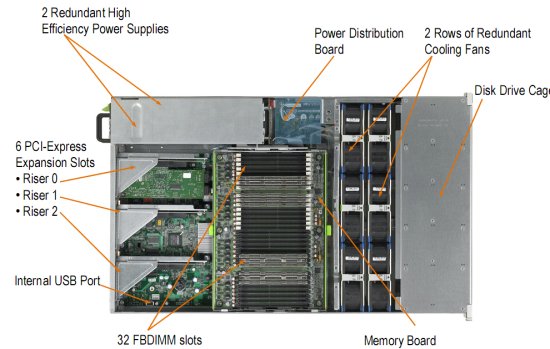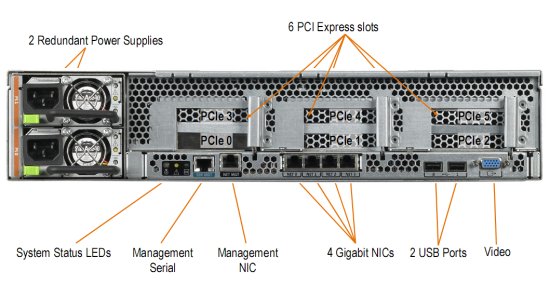Sun Fire X4450: Challenging the HP and IBM bastion
by Johan De Gelas on May 25, 2008 12:00 PM EST- Posted in
- IT Computing
The X4450 Up Close and Personal
When we look at the Sun Fire X4450, we find a few differences from the "reference" design. Six pairs of fans are easily accessible at the front of the server. If one fails, you just have to open the first part of the top cover door and replace the faulty fan. This is an advantage compared to other similar servers and the Intel S7000FC4UR for two reasons. The first reason is that all the fans are in one place - no searching is necessary. The second reason why Sun's approach is better is that if a rear fan fails on other servers, you will have to pull out the entire server to replace those fans in the back. You can imagine that this might be difficult if your server is located relatively high in a rack. Thumbs up for the Sun machine: it offers better serviceability.

The top cover is split into two parts. If you remove the main cover (the part in the back), the system will automatically enter standby mode. Sun makes use of two 1050W PSUs, which could save power compared to the 1570W power supplies found in the Intel S7000FC4UR. (Efficiency and other factors will of course play a role.)

The most remarkable part of the X4450 design is that the engineers managed to put a memory board on top of the CPUs and the Northbridge heatsink. The complete memory basket is easy to remove and does not require any tools as you can see below.

All servers claim to be ready for virtualization, but Sun and Dell have to have thought this through just a little better. Integrating four Gigabit Ethernet ports instead of two is a very smart move. For a typical ESX server you need:
- two ports (so you can offer your
virtual servers a total of 2Gb/s) for your virtual switch/network
- one port for the console
- at least one port to connect to your NAS or iSCSI SAN
In some virtualization scenarios, you'll use up to eight (!) gigabit ports:
- Two ports in fail-over for the
console
- Two ports in fail-over for Vmotion, giving you the ability to easily
move your virtual machines to other physical servers
- Two teamed ports to give decent bandwidth (2Gb/s) to all your VMs
- Two teamed ports for access to the iSCSI SAN
We admit eight ports might be a bit luxurious, but frankly there is little you can do with only two Ethernet ports these days.

Three risers allow you to plug in six different PCIe cards, which should be more than enough upgrade space for most applications. Let's see how Sun compares to its competitors:
| Server Feature Comparison | ||||
| Sun Fire x4450 | Dell PowerEdge R950 | HP Proliant DL580 G5 |
IBM X3850M2 | |
| Memory slots | 32 | 32 | 32 | 32 |
| PCIe | 2x PCIe
x8 4x PCIe x4 |
4x PCIe
x8 3x PCIe x4 |
4x PCIe
x8 4x PCIe x4 |
7x PCIe x8 |
| PCI-X | none | none | Optional | ? |
| Gigabit ports | 4 x 1 Gb/s | 4x 1 Gb/s | 2 x 1 Gb/s | 2 x 1 Gb/s |
| Disk trays | 8 x 2.5" SAS | 8 x
2.5" SAS or 5 x 3.5" SAS |
16 x 2.5" SAS | 4 x 2.5" SAS |
| PSU | 2 x 1050W | 2x 1570W | 2x1200W | 2x 1400W |
The HP server is the most expandable, but still forces almost every customer to buy an additional NIC. It's not a big deal, but it's still a small disadvantage. IBM is clearly counting on the fact that you'll use a SAN storage with this server. This is also only a small disadvantage as most users will combine this kind of server with a SAN. However, if you are looking for one big database server, the IBM will not fit the bill. Notice how the Sun Fire server has the PSU with the lowest spec, a first indicator of power consumption.










0 Comments
View All Comments